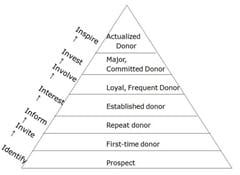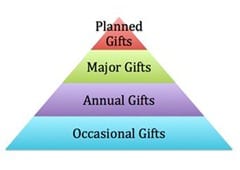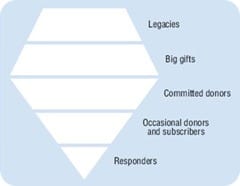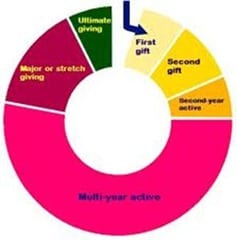Jun 2, 2022
The Fundraising Pyramid and the Donor Life Cycle

Find Your Supporters Wherever They Are!
The fundraising pyramid is a traditional starting point for defining the donor management and acquisition process. There are multiple versions of this pyramid (I found at least fifty images on Google). Below are a few variations that illustrate the same “bottom-up” fundraising approach: Prospects and Supporters followed by First Time donors, Repeat donors, Transitional donors, Major donors, Capital Campaign donors and Legacy (or Planned Gift) supporters.
#1 Karla-pyramid Philanthropy Watch
Ideally, each fundraising strategy matches the individual needs of the targeted audience; for example, an Annual Fund directed at prospects or a Major Gifts campaign for Established and Transitional supporters. One strategy in the pyramid is no more important than another. Rather, they are all connected in pursuit of revenue goals.
A common assumption is that development professionals seek to move donors “up the pyramid”. In addition, we must factor in the Pareto principle, that 80 percent of your gifts will come from 20 percent of your donors, as illustrated in diagram #3. This suggests that fundraisers should over-emphasize Major Gifts. Is this still true today?
Let’s examine some common assumptions of the fundraising pyramid paired with expectations of donors today:
First, I believe that “moving up” the pyramid is not as much the goal as is procuring the right mix of contributions in the different areas of the pyramid and or donor life-cycle to allow for a consistent revenue stream. Focusing only on Major Donors is shortsighted and ignores the Transitional donors, those that have demonstrated consistent giving for over five years. Further, a nonprofit needs to focus on the “long view,” sustaining a relationship over time so as to manifest a steady stream of lifetime donors, those that donate to your organization every year.
A Lifetime donor is a loyal supporter who contributes consistently over a long period of time, in addition to perhaps being involved in other activities such as volunteering or attending an event. The Donor Lifecycle better represents the relationship circle with a supporter versus segmenting based purely on the donation amount. Sarah Clifton created The Donor Life Cycle Map below that illustrates a donor’s journey:
Sarah Clifton’s The Donor Life Cycle Map
Second, bring a donor firmly “into the fold”. Procuring first-time donors often requires huge staff effort and typically more marketing expense. Retaining donors, therefore, is that much more critical. Penelope Burk said in The 2012 Cygnus Donor Survey, “Fundraising profit is not improved by acquiring more and more donors through costly and hard-hitting appeals: it is improved by retaining a reasonable number of donors longer and by securing significantly more generous gifts from them over time.”
Third, each phase of donor development demands a valuable donor experience. All donors expect recognition regardless of the gift size. Thanks to social media, the “universe” of prospects is less anonymous than in the past. The sentiment of donors can be gauged and thanked with a variety of digital tools, emotionally connecting even the most disparate potential supporters to a cause.
Fourth, donor segments are interconnected, necessitating the need for integrating Major Gifts and Gift Planning within development efforts. Scott Lumpkin, vice chancellor for advancement at the University of Denver points out: “Gift Planning and Major Gifts are not two separate areas but rather represent different dimensions of a gift. ‘Major gifts’ suggest ‘size’ and ‘Gift Planning’ describes ‘how’ a gift will be made.” Especially with planned giving, a supporter deserves more than just a “cash in” outlook.
Fifth, if used strategically, a Social Constituent Relationship Management (CRM) system can be used proactively to manage and automate the engagement process. Regardless of the current fundraising model embraced by your organization, a nonprofit needs a robust CRM to keep accurate records. Data can then be analyzed to determine both the number and type of supporters, giving history and trends of donor segments. In this way, the role of a CRM can be pivotal!
Today it’s important to understand the different types of supporters at your nonprofit and then determine what actions will keep donors most engaged throughout a long, happy relationship, wherever they are on the pyramid or in the Donor Life Cycle!
Related







